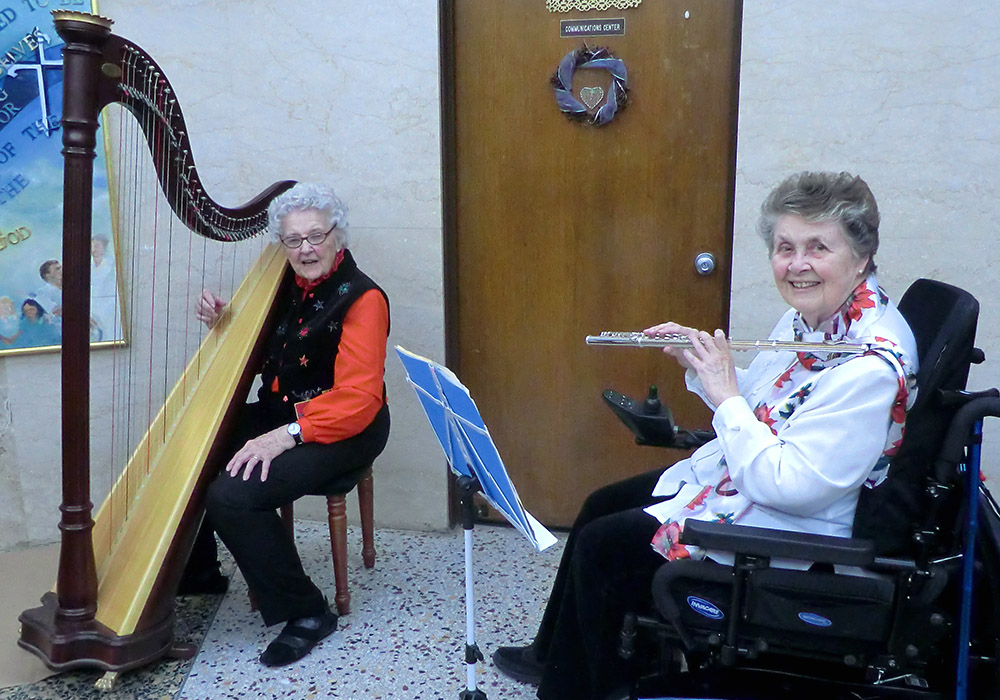
Dominican Sr. Mary Anna Euring, right, plays flute with Sr. Miriam Cecile Lenihan on the harp in 2016. Lenihan died last year. (Courtesy of Sr. Mary Anna Euring)
Sr. Mary Anna Euring has been a Sister of St. Dominic of Amityville, New York, for 64 years. Throughout the years, her ministry has included teaching elementary school, creating programs for children and adults with developmental disabilities, being a novice director, directing pastoral care at hospitals, and working with the sick and dying, including AIDS patients at the height of the crisis in the 1980s and '90s in New York City.
A few years ago, Euring went part-time in her job as director of pastoral care at Good Samaritan Hospital Medical Center in West Islip, New York, to focus on healing from cancer. (She is now in remission.) With her newfound free time, she took a class in Asian brush painting at her local art museum and discovered not only an extraordinary talent, but a deep love for art.
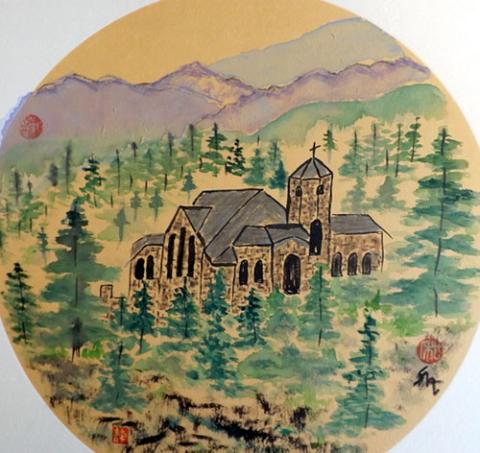
Dominican Sr. Mary Anna Euring painted this picture of the Chapel on the Rock in Allenspark, Colorado, after visiting with friends. (Courtesy of Sr. Mary Anna Euring)
"A friend once told me, 'We sisters, we don't retire, we re-engage.' Now, I re-engaged as an artist and a musician. Something I always wanted to do, and here I am, in my elder years, enjoying it," she said.
Currently retired at the motherhouse, where she entered religious life in 1956, Euring now paints daily at her desk overlooking the sisters' organic farm. She also does calligraphy and origami and plays the flute. She and her fellow sisters recently held a sale of her artwork, which raised $4,000 for the Opening Word program, which teaches literacy to immigrant women on Long Island.
She spoke with Global Sisters Report about her art practice, how it informs her spirituality, and the difference between creating something out of personal energy versus out of God's energy.
GSR: Please tell us how you discovered Asian brush painting and explain more about this medium.
Euring: I remember going to class on the first day and picking up the brush and feeling like I always had it in my hand. And it just took off. It never ceases to amaze me. The curious thing is I had my DNA tested, and I found out I'm 2% Asian.
I felt the energy. The Chinese call it the chi. However, the chi, the energy within you, wants to express itself, that's what comes out on the rice paper. And when we paint, it's not like a photographic representation of, say, a flower or a tree. You try to get at the essence of whatever it is that you are painting.
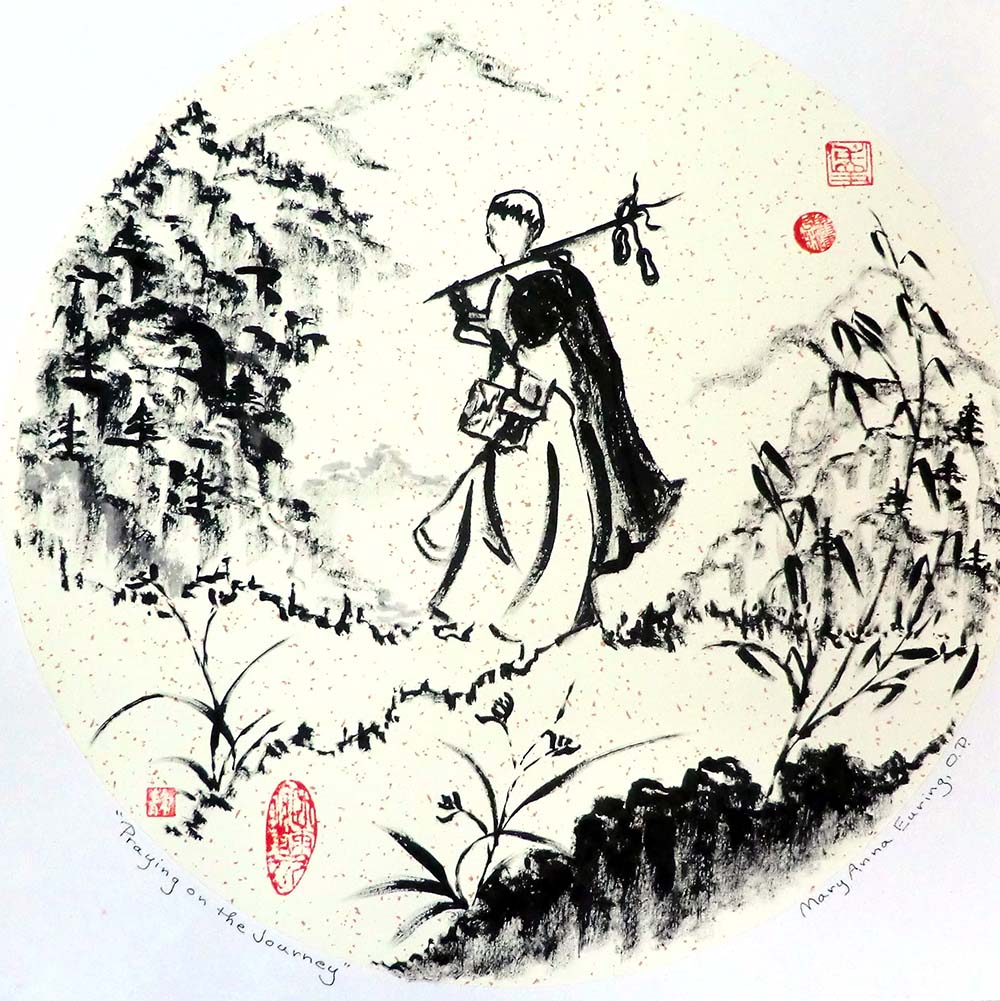
Dominican Sr. Mary Anna Euring's Asian brush painting of St. Dominic, the founder of her Dominican Order. "It depicts one of his favorite ways of praying: walking barefoot throughout Europe as he preached the Gospel," Euring said. "I used the simple tools of Chinese brush, black ink and rice paper to create this image that speaks of Dominic's joy and simplicity. Asian brush paintings attempt to capture the essence of what it is portraying, and this painting of Dominic sprang spontaneously from my desire to preach the Gospel message through my gift of art." (Courtesy of Sr. Mary Anna Euring)
It nourishes my contemplative spirit because the painting comes out of your contemplation. In your contemplation, an image may arise: usually nature, which I love, and I find God in nature. It may be a scene in nature, perhaps a mountain. And you pick up the brush, dip it in the ink, and as you start, something completely different may arise. And you just follow the brush. The brush takes the lead. They call it a dancing brush.
Asian brush painting is based on the Buddhist teaching of essence and being present to the moment. As Christians, that's what Jesus has always told us, too, to be present in the moment, in so many words. In the here and now. So, it all comes together for me. The painting has become my prayer. Whether I'm praying or contemplating or whether I'm painting, it all becomes one in that sense.
Each of your paintings has a prayer in it for the recipient. Can you tell us more about that aspect?
As I paint, I pray to the person who is going to receive it. People have told me afterward what it means to them.
One woman was telling me the story of her husband, who suffered from anxiety. She had a few of my paintings at home, and when he went through an anxiety attack, he would sit in front of one of my paintings and just gaze at it, and he would just become very calm and peaceful.
She told me when he was dying, he was gazing at one of my paintings. That's what he was looking at when he died. That was very touching to me because I know the power of the painting is beyond me. I know that God has blessed the paintings in such a way that they touch other people.
Advertisement
You have worked with many people and their families at the end of life, and now, your paintings are helping people at that moment. What insight do you have to share about death, and what is needed for people at that time?
It seems that God has prepared me for the ministry of working with people who are dying. I was never afraid of death. My father died six months before I was born. As a child, dying became a part of life. It wasn't something to be afraid of; dying was just a natural part of life. You know, the Zen circle of infinity. You live and you die, and then it continues. Being Christian, we know it continues in life with God.
What I've experienced from people and their families is that eventually, there comes the peace. If you allow yourself to be open to it instead of fighting against it, it opens up your soul. I think once we accept that it's part of life, it takes away a lot of the fear.
At times, I used to play my flute for people who were dying. Very calm, soft, soft music. Music and art speak beyond words. I think that's why the art means so much to people at a time like that. They can't put their experience into words, and they really don't even want people to talk to them. Words, words, words are too much. Whereas the art and music speak to their heart and speak to what they need to hear at that time.
When I taught chaplains, whatever I taught can be summed up into one word: presence. We don't have to say anything. Just being present to one another is the greatest gift we can give anybody.
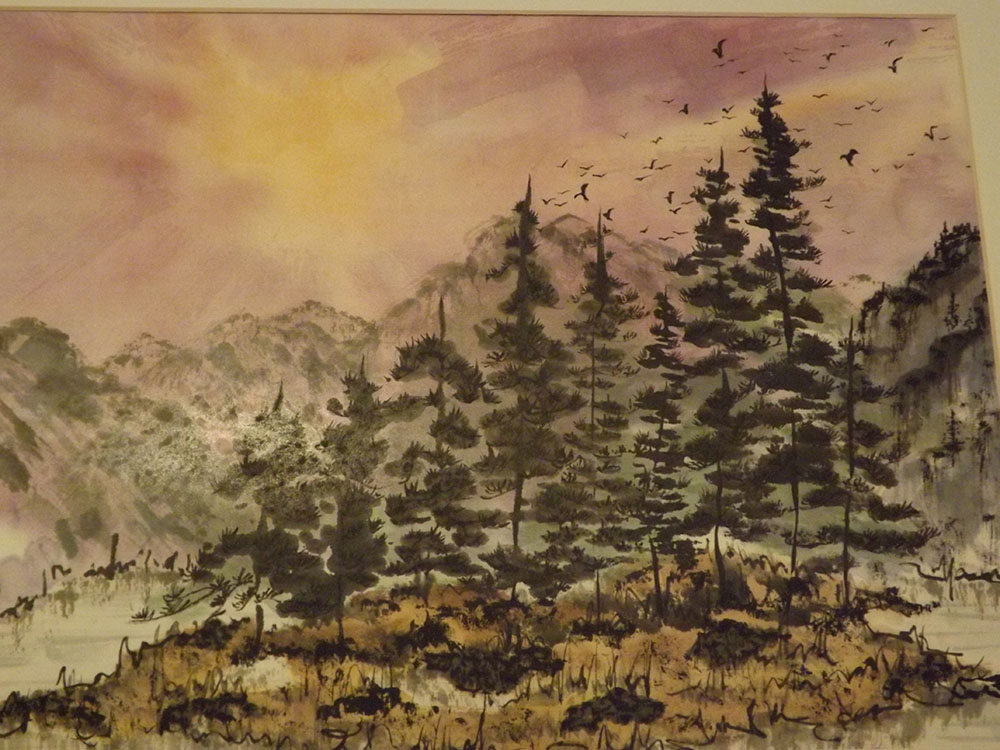
Dominican Sr. Mary Anna Euring calls this painting of the mountains "Morning Serenade" in honor of how the song of birds awakens the new day. "It is one of my favorite landscapes, which I saw while I was leading a retreat in the Canadian Rockies in 2001," Euring said. "Since I was still recuperating from spinal surgery, I sat meditating at this scene while the rest of our group went hiking. The peace I experienced while gazing at 'Spirit Island' has always stayed with me, and years later I finally painted it from memory." The original of this painting hangs in the emergency room of Good Samaritan Hospital Medical Center in West Islip, New York. (Courtesy of Sr. Mary Anna Euring)
How has your recent art-making informed your spirituality?
My prayer has changed over the years, from "Jesus and me" to "the world." I've been doing centering prayer since 1975, and it's the centering prayer that enlarged my image of God. It wasn't God up there. It was God within. Now, it's God within this evolving universe. My prayer, which I would describe as ecospirituality, is that whole sense of the cosmic Christ which includes everything. We're all one. There's no separation. And I think my art has brought me to that — the sense that we are all one.
God is ultimate mystery. That's why I love art, because the art can bring you down to that ultimate mystery. Especially when you have no control over the brush and the brush starts dancing, and you realize that must be how God created this world of ours, he just kind of danced it into existence. It's so — what's the word I want to use? Not "overwhelming." It's so exciting. It's still unfolding. It's absolutely amazing to me.
Has COVID-19 influenced your art?
I do a lot of calligraphy. The Chinese calligraphy for "crisis" is the same word for "opportunity." No matter what the crisis is, there's always an opportunity there for growth.
So even with this crisis of the pandemic, we could look at it in a strictly negative way and get angry, angry, angry, or else we could feel the anger and then allow it to move into something positive. We don't want to stop the anger because it holds a lot of energy. Hopefully, the energy comes out in creativity so that we can find new ways of relating to each other.
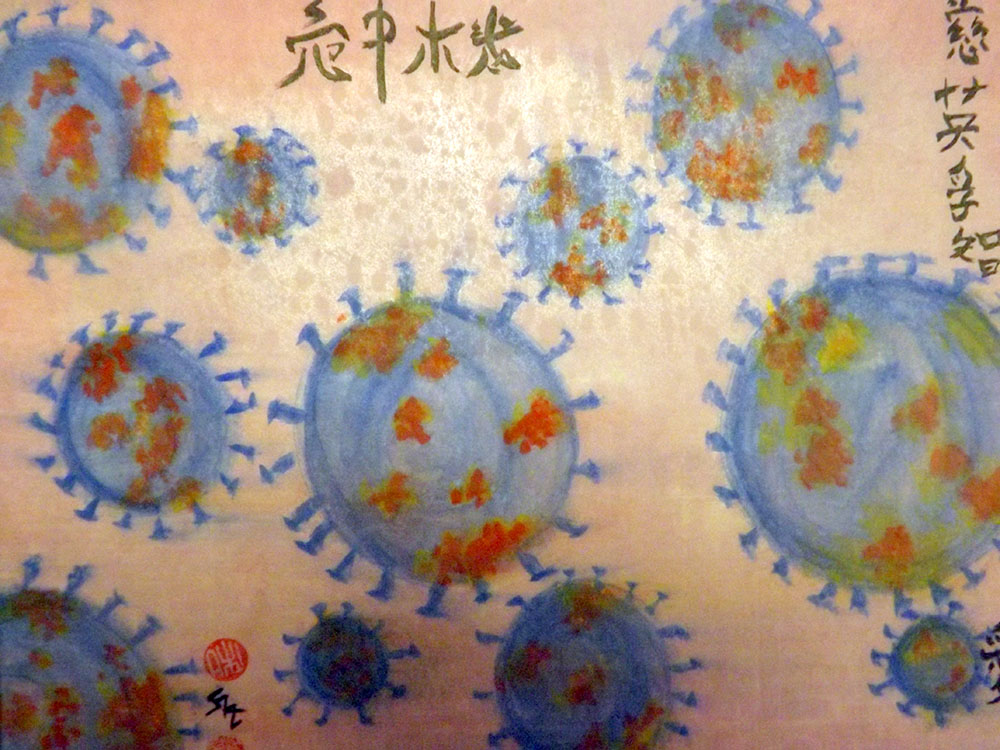
After Dominican Sr. Mary Anna Euring saw a photo of the coronavirus under a microscope, "I couldn't help but notice how beautiful it is in its flower-like, garland-shaped crown," she said. "Beautiful but lethal! Causing immeasurable havoc on minds, bodies and spirits around the glove, it has also brought me to reflect on the single Chinese character that means both 'crisis' and 'opportunity.' " (Courtesy of Sr. Mary Anna Euring)
Could you please share more about your understanding of the energy that drives creativity?
When something is from God, there's no stopping it. It just continues and gets bigger. The Opening Word program is like that. It started as a program teaching women and helping them get their high school diploma. Now, it's a whole literacy program. You follow the leads; you look at the signs of the times.
I know the difference. I know my energy, and I know God's energy. God's energy is usually something that you never even dreamt about that you could do, and your life just kind of brings you to it and then it just opens up and the creativity just flows out of whatever you're doing.
When God's energy is involved, it doesn't stop. It's boundless. Boundless. Because God is boundless. When it's just you, and you have a great idea, it might just be you. There's some energy in that, but it doesn't have that spark, it doesn't have the fire behind it.
When it's God's energy, you can be giving 110%, but you know it's not all you, so you're very humbled by it. Even this art show for the women, to make $4,000, I was so humbled by that. I said, "God, God, look what you did."
[Georgia Perry is a journalist based in Denver.]







